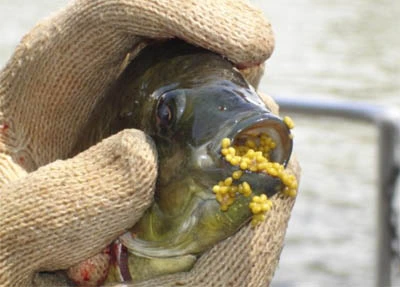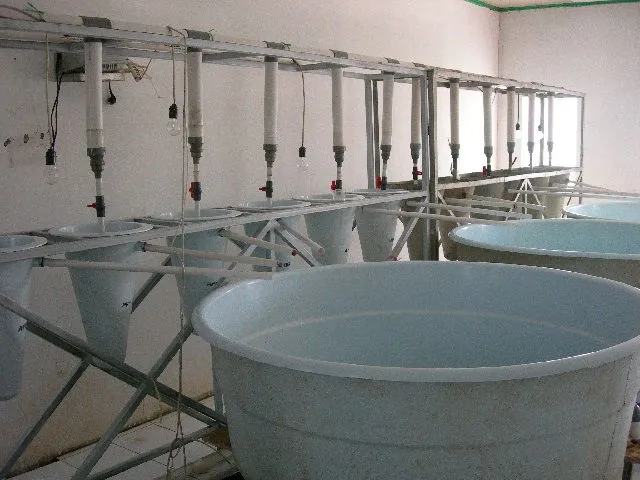Hatching tilapia eggs is an important stage in fish hatchery. This process is quite crucial in determining the success of tilapia farming. You need to ensure that the hatching of tilapia eggs must be done in a proper and careful manner.
If not, the mother tilapia can release the eggs from her mouth, so the eggs can be scattered and difficult to collect. You also need to do the right treatment, so that the eggs that have just been released from the parent's mouth are still in good condition.
As professional and novice cultivators, you need to complete your knowledge about the characteristics of quality tilapia eggs and how to incubate tilapia eggs. Check out the reviews here!
Characteristics of Good & Bad Tilapia Eggs

In one spawning, female tilapia can release as many as 300-800 eggs, depending on the size of the mother tilapia body. Good quality tilapia eggs are yellowish in color with a diameter of 2.8 mm, float on the surface, are not sticky, are round in shape, and have an egg core.
Meanwhile, bad tilapia eggs have the characteristics of being milky white and sink to the bottom of the surface. It should be noted that tilapia eggs are susceptible to fungal attack. If the eggs that have hatched are covered with fungus, they will be of poor quality and will not hatch, then rot.
Good eggs are obtained from healthy and unblemished parents. Good eggs produce healthy seeds, fast seed growth, and disease resistance. Tilapia eggs that are not good will produce fish seeds that are unhealthy, deformed, grow slowly, and are susceptible to disease.
Causes of Tilapia Eggs Not Hatching
Tilapia can produce eggs ranging from 300-800 eggs at a time depending on the size of the broodstock. Tilapia can spawn 4 times a year, it can even be more if it is done intensely and if the female parent is ± 8 months to 3 years old.
Although tilapia eggs are quite a lot, not all fish eggs will hatch. Even though you have taken the steps to incubate tilapia eggs that are good and right, tilapia eggs that fail to hatch may still happen.
The following are the causes of tilapia eggs not hatching.
1. Uncooked Eggs
The eggs in the mother's stomach have a level of gonadal maturity (TKG). If the tilapia eggs are still young, it can result in the eggs not hatching.
2. Water Quality is Decreasing
Good water quality can speed up the process of hatching tilapia eggs. Conversely, water that is of poor quality and contains heavy metals can cause death to tilapia eggs.
You are advised to maintain the quality of the water so that it remains clean and clear, so that the hatching of eggs can be carried out properly and produce good quality seeds.
3. Temperature Too High
Temperature is an important factor in the hatchability of tilapia eggs. The optimal water temperature for tilapia cultivation is 25-30℃. If the temperature in hatching eggs is > 33℃, it will reduce the hatchability of the eggs. Conversely, at lower temperatures, egg hatching can be hampered.
4. Expired Eggs
The female tilapia parents have mature gonads but are not immediately fertilized by the sperm cells of the male brooders, so that when spawning the eggs have entered their expiration date or the eggs are old.
5. Fungus Attack
Tilapia fish eggs have a high enough protein content that mushrooms like. This results in the fungus sticking to the tilapia eggs, which can result in failure in hatching the eggs.
The characteristics of moldy eggs is the appearance of fine white threads like cotton. Eggs that are attacked by the fungus will rot and die.
6. The male sperm cells are not ready to fertilize
In the spawning process, male sires who are not ready to fertilize will result in failure in hatching eggs, so that the eggs are difficult to hatch optimally.
How to Hatch Tilapia Fish Eggs
The process of hatching tilapia eggs needs to be done carefully. This aims to minimize the low hatchability of eggs which causes at least tilapia seeds to be obtained. Hatching tilapia eggs can be done by two methods, namely the conventional method and the intensive method (using a hatching funnel).
In the conventional method, the parent tilapia that lays eggs will hatch after 4-6 days after fertilization. The eggs that have hatched are not immediately released by the mother, but remain in her mouth.
The yolk of the larvae will run out after 5-7 days. After the yolk runs out, the larvae will look for food around them and the mother tilapia will continue to look after them by following the group of swimming larvae.
The female parent will release the tilapia larvae when they can swim and are safe from other animals. If the environmental conditions are not safe, the tilapia parent will suck the larvae back. Altogether, this process lasted 18 days.
After you know how to hatch tilapia eggs using conventional methods, it's time for you to know how to hatch fish eggs using a hatching funnel. Here's the review:
1. Egg Harvesting
Egg harvesting is done by reducing the pool water volume to a maximum height of 10-20 cm. Egg harvest was carried out on the 9th day after fertilization.
You need to do the egg harvest carefully so that the tilapia parents don't feel threatened. If the mother fish feels in danger, it is feared that the parents will release their eggs anywhere, making it difficult for the cultivators to collect tilapia eggs.
2. Catch the Parent One by One
You need to catch the parents one by one to get fish eggs. Before catching broodfish, you need to prepare a filter to make it easier to catch tilapia broodstock. The filter used is a coarse filter which functions to catch the broodstock and a fine filter to collect tilapia eggs.
3. Collecting Eggs from Females
The process of taking eggs from female brooders is done by holding the head of the fish. At the same time one of the fingers opens the mouth and closes the gills of the tilapia.
After that, you can close the gills and then flush the mouth of the fish using water so that the eggs can come out. Then, the eggs are accommodated in the container provided. You must do this process carefully to minimize the movement of the parent fish so that the eggs don't scatter.
You need to ensure that the eggs that have been accommodated in the container are not exposed to direct sunlight. In addition, make sure the eggs are always moving because fish eggs are vulnerable to death.
4. Hatching Eggs
You can clean the eggs obtained from the mother fish before putting them into the hatching funnel. Make sure the hatching funnel is protected from rain and direct sunlight to prevent mold growth.
In the hatching funnel there are pipes for inlet and outlet of water. The inlet pipe is at the bottom of the hatching funnel, while the outlet pipe is located at the top of the hatching funnel.
The way the hatchery funnel works is to drain water from the water reservoir (with the help of a water pump) into each funnel through a hose and pipe.
Water that enters the funnel will generate a current that can move the eggs, so that the eggs in the hatching funnel will rotate continuously.

You need to keep the temperature of the hatching funnel in the range of 28-30 ℃. With ideal temperatures, fish eggs can hatch in 1-3 days. Then, you can provide water in the hatchery pond methyl blue to prevent bacterial infection.
5. Harvesting Larvae
Eggs that have hatched and become larvae will swim with the flow of water from the hatching funnel to the holding tank. After that, you can carry out the process of harvesting tilapia larvae.
Hatching funnel system eggs is a simple technology, but very effective in increasing the hatchability of eggs or hatching rate (HR) and survival of tilapia fry above 90-95% (with well-stirred egg conditions), compared to conventional hatchery systems of only 30-50%.
Factors Affecting Egg Hatchability
Tilapia hatchery plays an important role in the need for seeds, especially in the process of hatching eggs. The problems faced in hatching tilapia are the low hatchability of eggs and the level of hatchability survival rates (SR) is also still low.
Many factors affect the hatchability of fish eggs. Here's the review:
1. Egg Quality
The first factor that affects egg hatchability is the quality of the egg itself, such as egg weight, egg shape, eggshell integrity, eggshell quality, and eggshell cleanliness.
Egg quality is also influenced by the quality of the feed given to the broodstock and the maturity level of the eggs.
2. Environment
Environmental conditions such as water quality affect egg hatchability. The temperature range for hatching tilapia eggs ranges from 27-30℃ and the optimal temperature for hatching eggs is ± 29℃. In addition, the optimal pH for hatching tilapia eggs ranges from 6.5 to 8.5.
3. Water Movement
Another factor is that the water movement is too strong. This can cause a hard collision between the eggs or other objects, causing the eggs to break.
Grow Tilapia Cultivation Business with Support from Kabayan!
Penetasan telur ikan nila dapat menentukan keberhasilan budidaya. Kabar baiknya adalah kini budidaya ikan nila bisa lebih mudah dengan aplikasi eFisheryKu
eFisheryKu adalah aplikasi yang dibuat untuk membantu Bapak/Ibu memajukan bisnis budidaya ikan. Aplikasi ini dilengkapi dengan berbagai fitur untuk mendukung proses budidaya, seperti akses ke lembaga keuangan yang terpercaya, terdaftar, dan diawasi oleh OJK, melalui Kabayan (Kasih, Bayar Nanti).
As is Kabayan, Bapak/Ibu bisa mendapat pakan, benih, dan sarana produksi lainnya yang bisa dibayar setelah panen. Keuntungan menggunakan Kabayan lainnya adalah proses cepat, bunga rendah, persyaratan mudah, akad perjanjian bisa secara syariah, pemesanan pakan atau saprokan melalui aplikasi, serta promo menarik lainnya. Pengajuan Kabayan it's also easy, you can register through the application eFisheryKu.
Tunggu apa lagi? Nikmati berbagai kebermanfaatan Kabayan dengan mengisi form di bawah ini!
Get Access to Financial Institutions that are Trusted, Registered & Supervised by OJK!
Fill in your personal data in the following form. Our team will immediately contact you via the number cellphone attached. Make sure the data entered is correct.
Questions About How to Hatch Tilapia Eggs
Hatching tilapia eggs can be done in two ways, namely the conventional method and by using a hatching funnel.
The hatching time for tilapia eggs is approximately 4-6 days after fertilization. The eggs will hatch simultaneously and become larvae.
The female tilapia parent will care for the larvae for 18 days. The female parent releases the larvae when they can swim and are safe from other animals. If the environmental conditions are not safe, the tilapia parent will suck the larvae back.
There are many factors that cause tilapia eggs not to hatch, such as immature eggs, expired eggs, decreased water quality, high temperatures, fungal attacks, and the male's sperm cells are not ready to fertilize.
- https://www.djpb.kkp.go.id/index.php/mobile/arsip/c/541/PASTIKAN-PASOKAN-BENIH-KKP-KEMBANGKAN-TEKNOLOGI-CORONG/?category_id=14
- https://id.scribd.com/document/540549795/Penetasan-Telur-Ikan-Nila-Menggunakan-Corong-Penetasan
- https://www.dictio.id/t/apa-yang-menyebabkan-telur-ikan-gagal-menetas/106383
- https://kkp.go.id/djpb/infografis-detail/12150-penetasan-telur-ikan-nila-sistem-corong
